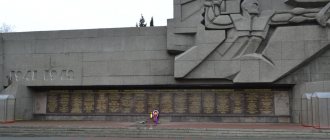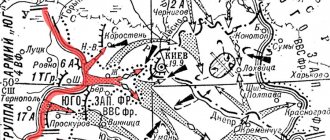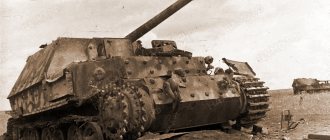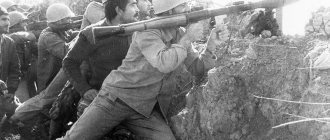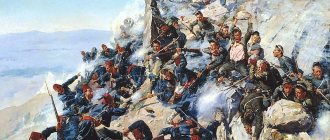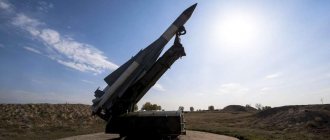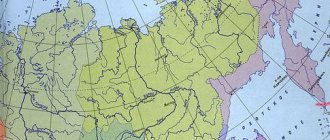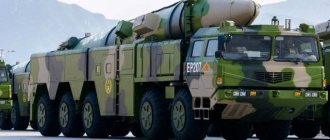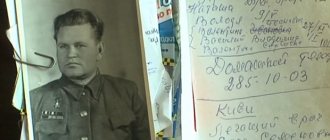The defense of Kyiv was a catastrophic defeat for the Soviet army. But the heroic resistance of the spacecraft fighters greatly slowed down the advance of the Wehrmacht forces, which gave a strategic advantage over the enemy in the future. By slowing down Army Groups “South” and “Centre”, the heroes of the Second World War made it possible to pull up reserves to Moscow and repel the Germans.
The defense of Kyiv was a major battle during the Great Patriotic War, in which the forces of the Soviet army and the Wehrmacht took part. The attackers, Nazi Germany, planned to take possession of Kiev as a strategically important city. The defenders, the USSR, wanted to protect the city, preventing the armies of the groups from advancing deeper into the country.
Interesting! The battle ended in a crushing defeat for the Red Army, whose losses exceeded 700 thousand people. By comparison, the Germans lost just over 100 thousand soldiers.
On June 22, 1941, the army of Nazi Germany and its allies began sudden military operations against the USSR. In the first months of the war, the Red Army suffered catastrophic defeats, and just two weeks after the offensive, the capital of Ukraine (Ukrainian SSR), the city of Kyiv, was taken under siege.
German traffic controller in occupied Kyiv
The reason for the defeat was Stalin’s “reforms” (repressions) towards the officers of the spacecraft. The lack of experienced military leaders made it impossible to organize a coherent defense. However, historians also consider a number of other reasons:
- Lack of defense plans.
- The suddenness of the enemy's attack.
- The army is poorly equipped with weapons, equipment and ammunition.
The defense of Kyiv became a key task for the spacecraft command, since the enemy was approaching Moscow, the defense of which had not yet been prepared.
To capture Kiev, Hitler sent the army group "South" , the second army from the army groups "Center" , as well as the second tank army under the leadership of the pioneer of tank forces - Guderian. The German units were also commanded by Field Marshal Rundstend and Field Marshal von Kleist.
The commander-in-chief of the heroic defense of Kyiv in 1941 was led by Marshal of the USSR Semyon Budyonny. Under his command, the troops of the Southwestern Front were commanded by Colonel General Kirponos. Assistance in the defense of Kyiv was also provided by units of the Pinsk flotilla under the leadership of Rear Admiral Rogachev.
Marshal of the Soviet Union S.M. Budyonny at the USSR Embassy
On the eve of the Kyiv operation of 1941
Before the attack on the city of Kyiv, General Guderian warned Adolf Hitler that this attack on Kyiv would play a cruel joke, thereby delaying the attack on Moscow would allow the Russians to pull up reserves from Siberia.
Interesting! Hitler considered that the capture of Kyiv was a priority goal, which as a result became one of the main reasons for Germany’s defeat on the Eastern Front.
On June 30, Hitler issued a directive for Army Center groups to go on the defensive, and for Army South to destroy large enemy groups to the West of the Dnieper, including in the city of Kyiv.
600 thousand Red Army soldiers were collected to defend Kiev . During the defense itself, the Headquarters sent 30 divisions.
Human losses and the courage of the Red Army
Every schoolchild and adult knows how long the defense of Kyiv lasted in 1941. No one can forget the bloody battles, courage, and heroism of the Red Army. Everyone will remember how the soldiers fought for the capital and defended it as best they could. Not a single soldier had any thoughts of leaving the battlefield and giving the capital into the hands of the enemy. These events will remain in the memory forever, because it is simply impossible to forget them.
It must be said that the defeat of the Red Army was a huge blow for the entire country and greatly influenced the further development of the Great Patriotic War. The hostilities claimed the lives of over 700,000 people. In addition to the enormous human losses, the USSR lost almost all of Left Bank Ukraine. Because of this, the road to the Donbass, the Azov region, and also to Eastern Ukraine became open for German troops.
First strike on Kyiv
The forces of the USSR were in a difficult situation. The enemy was rapidly advancing and the government ordered the withdrawal of the troops of the Sixth Army to organize a line of defense in the Berdychev area. The Fifth Army took up defensive positions in the Korostel UR (fortified region). Between these defensive lines there was a 60-kilometer poorly fortified area, where Field Marshal Kleist ordered the tank group to launch an offensive; as a result, it was not possible to stop the enemy rushing towards Zhitomir.
German machine gunner in the burning city of Zhitomir
With a swift attack from tank units, the Germans broke through the defenses, as a result of which the city of Zhitomir was conquered on July 9. After capturing the city, the enemy launched an attack on Kyiv with the forces of two divisions. Two days later, fighting began in the Kiev fortification area.
General Potapov ordered the Fifth Army not to wait for the Wehrmacht to strike, but to launch a counteroffensive themselves. The Germans were obliged to repel attacks by Soviet troops, which is why they were bogged down in positional battles for several weeks. The Red Army managed to break the rapid offensive and delay the assault on the city. While repelling attacks, the Germans waited for reinforcements in the form of the Wehrmacht's Sixth Army.
This counter-offensive also made it possible to disperse the German attack - parts of their armies fanned out, which made it impossible to launch a swift attack on the capital of the Ukrainian SSR.
In the second half of July 1941, the Germans also launched an offensive in the Vinnitsa area. The Red Army was unable to repel the enemy attack and was forced to surrender the city. Retreating, the USSR forces opened a gap in the front near the city of Belaya Tserkov, which the Germans immediately took advantage of. The Soviet army began to retreat to the city of Uman. The Germans caught up with the retreating people and drove them into the so-called “Uman cauldron” .
Battles near Uman 1941
Already at the end of July, the Wehrmacht forces were ready to launch an offensive in the southern direction - the road to Kyiv was open.
Threat of encirclement
At the beginning of August, the forces of the Army “South” continued to advance and two weeks later they managed to conquer the territories along the Dnieper River from Kherson to Kyiv itself. The forces of the “Center” armies advanced towards the city from the northern direction, capturing the city of Smolensk.
Battle near Smolensk
On August 20, Wehrmacht tank divisions crossed the Dnieper near the city of Zaporozhye, and two days later the crossing in Dnepropetrovsk was captured. Soviet units under the command of General Potapov continued to retreat. These actions of the Red Army troops created the conditions for another cauldron in which the forces of the Southwestern Front found themselves.
Kyiv cauldron 1941
Shortly before the defeat of the armies of the Southwestern Front (USSR) in the “Kiev cauldron,” Guderian met with Hitler, advising him to immediately storm Moscow. The Fuhrer rejected the advice of his military commander and gave the command to take Kyiv.
Zhukov advised Stalin to withdraw the forces of the Southwestern Front in order to prevent the threat of encirclement and defeat. One head of the USSR removed Zhukov from his post for his defeats in the first two months of the war.
The Soviet command withdrew all troops beyond the Dnieper, with orders to hold only Kyiv.
Meanwhile, the encirclement of the capital continued. Units under the command of Guderian were initially sent to Poltava, but turned to the cities of Novgorod-Seversky and Korop, seizing bridgeheads for the attack on Kyiv.
German Colonel General Heinz Guderian
Here the troops of the Bryansk fort tried to launch a counterattack to Guderian’s units. However, due to inconsistency in their actions, they failed to achieve their goal - the Germans successfully defended and defeated the Soviet army. The USSR suffered heavy losses during the bloody battles.
The Germans continued their offensive and units under the command of General Weichs, who had previously defeated the armies of the Hungarian-Slovak Republic, set off towards Chernigov. After this, Weichs helped pin down the Soviet units on the Bryansk Front.
On September 7, 1941, Guderian's corps reached Konotop. Budyonny once again asked Stalin to withdraw the troops of the Southern Front, who would be completely encircled, but the commander-in-chief refused. On September 10, the armies of the South-Eastern Front had exhausted their reserves, and the enemy continued to tighten the ring.
The headquarters believed that the front was capable of holding off an attack by German troops near Kiev, and therefore there could be no talk of any retreat. Due to demands for Budyonny's withdrawal, he was removed from front command.
Kyiv, 1941 - the largest of the surrounded Red Army groups
A gigantic ring of encirclement around the Kyiv group of the Red Army closed on September 15. The Soviet command gave the order to begin the retreat too late. In the cauldron there were 4 armies, badly battered in battles, more than 450 thousand people. This was a very large group that could stand up for itself. But only if it is competently managed.
However, unfortunately, it was very quickly disorganized by the decisive actions of the enemy and the weakness of the command of the Southwestern Front, which in a matter of days lost control of the troops.
Bryansk front. Tankers Grigory Breslavets and Ivan Venzhega after the battle with Guderian’s tankers going into the breakthrough. September 1941
The group participating in the defense of Kyiv quickly fell apart into separate groups, each of which was independently looking for a way to break out of the ring. The roads were clogged with disorganized rear columns of thousands of cars and carts. They were fired upon by enemy aircraft and artillery with impunity. This created and intensified confusion in the troops, over which there was no longer a common command.
The surrounded groups, trying to break through to their own, gradually split into smaller units. Nevertheless, in total, about 30 thousand soldiers and officers managed to escape from the Kyiv encirclement of 1941, including the remnants of General Vlasov’s 37th Army, which found themselves locked at the farthest end of the cauldron. At that time, Andrei Vlasov still showed himself as an exceptionally reasonable, energetic and completely loyal military leader to the Soviet regime.
Result of the operation
On September 13, USSR Marshal Timoshenko arrived to command the front and assured Stalin that he had enough strength to hold Kyiv.
The Germans, meanwhile, continued to encircle the front from all sides - attacks were launched from the western, southern and other directions.
On September 15, the giant ring completely closed, which meant that several armies would soon be defeated.
Being completely surrounded, Timoshenko radically changed his point of view and asked Stalin to withdraw his troops. The government allowed only the command to leave Kyiv, and there was no information about the main military formations.
On September 17, the army finally received permission to leave Kyiv and go for a breakthrough, and after a couple of seconds, contact with Moscow was lost.
In fact, there was no longer any talk of any breakthrough. The Soviet army was fragmented and also divided into separate small groups. The morale of the soldiers was at zero, which was also compounded by the huge losses received in previous battles with the enemy. The battle near Kiev was already lost.
Result of the battle
During the fighting, more than 450 thousand people, a huge number of artillery pieces, mortars and several dozen tanks ended up in the cauldron.
Kyiv cauldron 1941
In total, during the battles, the Germans captured more than 600 thousand Soviet soldiers. In total, as a result of the heroic defense of Kiev, the USSR's losses amounted to about 800 thousand people, tens of thousands of guns, mortars, and a large number of tanks.
Defense of Kyiv 1941. Briefly about military operations
The Great Patriotic War claimed a huge number of lives of heroes. No one can forget how the Red Army troops defended their homeland from the enemy.
The defense of Kyiv in 1941 became a very difficult period for the Red Army and the townspeople. Despite the unequal forces, the Red Army men stood to the last and committed desperate acts in order to prevent the German troops from advancing further. Most Red Army units lost contact with the high command, as well as with neighboring units. Many of them were surrounded and could no longer escape from it. It is worth saying that most of the soldiers died or were captured by the enemy.
Second blow to Kyiv
In the second half of July, the enemy failed to immediately take the city. The second attempt began shortly after the ring around Kyiv was closed. On September 19, the city was abandoned. Due to fragmentation, it was not possible to organize a decisive and dense defense. The Thirty-Seventh Army was able to hold off the enemy until September 23, after which it was captured - most of the soldiers at that time were killed.
The Fifth and Twenty-First armies held the defensive lines until September 25, after which their remnants were also captured. The Twenty-sixth Army held out the longest - it stood until September 26.
Some smaller units of the Soviet army tried to break out on their own, but the Germans did not loosen the ring, and all efforts to break through ended in failure.
On September 26, the Kiev defensive operation was officially completed.
Remains of a barricade in Kyiv 1941
The capture of Kyiv by the Germans in 1941 - date
Soviet troops left Kyiv on the night of September 18-19. They retreated to the left bank of the Dnieper and blew up the bridges behind them. On the same day (around noon on September 19), Wehrmacht reconnaissance and assault detachments appeared in cars, motorcycles and armored cars in the capital of Soviet Ukraine.
They entered the city simultaneously from two sides - from Krasnoarmeyskaya Street and from Podol, assessed the situation, and in the afternoon the city was occupied by the main forces of the Nazis.
One of the bombed buildings. Photo September 24, 1941
From September 24 to 28, a whole series of explosions of radio-controlled mines thundered in Kyiv, which Soviet demolitionists planted in many buildings during the retreat. As a result, a number of German soldiers and officers died. The sabotage did not end there: a whole network of underground workers remained in Kyiv specifically for their organization.
Consequences
The strategic position of the Red Army forces after the defeat near Kiev turned out to be catastrophic. The Germans received full access to the territory of Eastern Ukraine, which made it possible to subsequently capture the Donbass (October 17), an economically important region for the Union. Wehrmacht forces then occupied:
- Crimea
- Kharkiv
- Odessa and a number of other important cities
Guderian noted that the capture of Kyiv was a brilliant victory from a tactical point of view, however, as far as strategy was concerned, it was a complete fiasco.
The military leader said that “we don’t have enough time to capture Moscow before winter.”
The catastrophic defeat of the Red Army gave it a great strategic advantage. The Germans significantly lost momentum - this allowed them to bring in fresh reserves and organize the defense of Moscow, which ended successfully.
Reasons for the battle near Kyiv
After German troops captured the territory near Smolensk, Hitler decided to attack Kyiv in order to soon conquer all Ukrainian lands. He wanted to capture Ukraine because there were coal deposits on its territory. Hitler believed that this would help provide the German troops with warmth and food so that they could continue military operations in the territory of the Soviet Union.
After the seizure of Ukrainian lands, it was planned to encircle Moscow, and then achieve surrender from the USSR.
Medal "For the Defense of Kyiv"
In 1961, the award “For the Defense of Kyiv” was officially established, which was awarded to more than 100 thousand military veterans who took part in the battles for Kyiv. In addition, the medal was awarded to all militias who helped build defensive fortifications and to all partisans.
Medal "For the Defense of Kyiv"
The official date of the Kyiv defensive operation is from July 7 to September 26, 1941.
Progress of the Kyiv defensive operation
The Kiev defensive operation lasted from July 7 to September 26, 1941. Although it ended in disaster for the troops of the Southwestern Front, such a long delay thwarted all the Nazis’ plans to wage a “lightning war” and defeat the USSR even before the end of 1941.
Defensive battles in July and early August
On July 7-11, German tank units attacked the positions of the Southwestern Front, captured Berdichev, Zhitomir, and reached the Irpen River (near Kiev). However, the Soviet units not only successfully defended themselves, but also went on a counter-offensive in many areas, so the Nazis failed to capture the Kiev fortified area on the move, and the battles became protracted.
Until the 20th of July, Soviet troops not only held Kyiv and its fortified area, but also successfully counterattacked, forcing the enemy to retreat from the territories they had already occupied. The Nazis, using their advantage in armored forces and the large length of the front (300 km), tried to strike north and especially south of Kyiv, on the territory of the Cherkasy region. Two Soviet armies fell into a “cauldron” near Uman; there was a danger of envelopment from the flanks of the Soviet group in Kyiv.
On August 7, reinforcements were sent to Kyiv - an airborne brigade and 2 rifle divisions. As a result, another attempt to storm the Kyiv fortified area was repelled. By mid-August, the situation near Kiev had stabilized: Soviet troops were ready to continue to hold the line.
Strategic Planning Mistakes
However, further decisions of the Soviet Command Headquarters were based on incorrect information about the enemy’s plans, which led to the disaster near Kiev. The Soviet military leadership proceeded from intelligence data that reported that the main direction of Hitler's attack in 1941 would be Moscow. Accordingly, the main efforts were aimed at strengthening the western, rather than the southwestern and southern directions.
This information corresponded to reality when it was received by Headquarters; but Soviet intelligence did not have time to receive and transmit to the command information about changes in the enemy’s plans. On August 20, Hitler rejected the plan of Chief of the General Staff F. Halder, which proposed a powerful attack on Moscow by Army Group Center. Instead, the Fuhrer declared the capture of Crimea and Donbass a priority and on August 21 gave orders to send part of the troops of Army Group Center against the Southwestern Front.
The USSR learned about these changes in the enemy’s plans only when the 2nd Panzer Group of H. Guderian (who was an opponent of this development of events and even argued with Hitler about this, but obeyed the order) had already begun moving south. Marshal S.M. Budyonny, who exercised overall command in the southwestern direction, proposed on August 16 to withdraw the troops of the Southwestern Front to the left bank of the Dnieper, but his opinion was not heeded. Then Budyonny several more times suggested giving the front an order to retreat - this could help avoid catastrophic losses. But this position ultimately cost the marshal his command, and time was lost.
Developments in August-September
H. Guderian with his tank group advanced in the direction of Konotop (northeast of Kyiv). The Bryansk Front received the order to stop him, but the operation was poorly prepared and failed.
At the end of August, the tank group of P. von Kleist began an offensive towards Guderian in the direction from Kremenchug to the northeast. It was planned not just to cover Kyiv, but also to see the fascist tanks reach the deep rear of the Southwestern Front.
M.P. Kirponos received an order on August 19 to withdraw troops to the left bank of the Dnieper, but continue to hold Kyiv. Having received unequivocal orders in July and August to hold Kyiv at any cost, the Colonel General did not dare to appeal to the command with a request to allow a withdrawal and was determined to continue the defense. He only asked for reserves, but they were gone.
On September 12, Marshal Budyonny was removed from overall command for proposing to withdraw troops of the Southwestern Front from Kyiv. His replacement, Marshal S.K. Tymoshenko expressed confidence that Kyiv will be able to be retained. At this time, the almost surrounded Soviet units had only a narrow “corridor” 40 km wide in the area of the city of Lokhvitsa to exit the “cauldron”.
September 16 to M.P. Kirponos received I.Kh. Bagramyan as a representative of S.K. Timoshenko with the order to leave Kyiv and retreat to the banks of the Psel River. But Kirponos did not believe the order, which was transmitted orally and contradicted all the orders he had previously received. He requested (and received) confirmation of the order, but this caused a final, fatal delay to the retreat. The order was given only late in the evening of September 17th.
In fact, on September 15, the Nazis closed the encirclement at Lokhvitsa. Although they were subjected to constant strong attacks by Soviet units, the exit of the encircled was very difficult. Conduct an organized retreat of M.P. Kirponos failed; in most cases, individual units tried to act on their own.
On September 20, 1941, the front headquarters column was attacked by German tanks near the Dryukovshchina farmstead near Lokhvitsa. The entire front headquarters and most other officers were killed (including M.P. Kirponos), the few survivors were captured.
On September 26, the resistance of units of the 26th Army in the Orzhitsa area ceased. This ended the Kyiv defensive operation.

